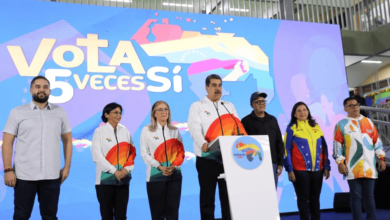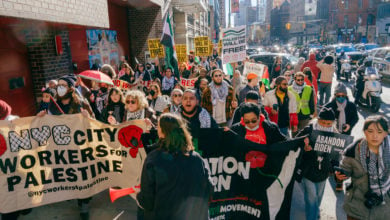As Venezuela’s referendum nears, the pro-Chávez majority of the population is mobilizing to vote “Yes” on Dec. 2 to proposed constitutional changes, and then, to fight to defend that vote.
Only days before the vote, orchestrated attacks by opposition groups are increasing and a destabilization campaign is fully underway, directed and financed by Washington. A newly-discovered CIA communiqué calls for intensified attacks after Dec. 2.
José Aníbal Oliveros Yépez, a 19-year-old worker with Petrocasas in the city of Valencia, was murdered on Nov. 26. He was shot in the back by a group of opposition thugs responding to the CIA and Venezuelan right-wing’s call for terrorist violence to intimidate Chávez supporters. Petrocasas is a social project to build houses. Oliveros’ death has caused great consternation in the public.
This week Chávez denounced new assassination plots against him, after a red laser light was pointed at him in a public rally, indicating that a gun’s sights were possibly fixed on him. Cuban president Fidel Castro urged him to take more precautions.
These incidents are consistent with a newly-revealed CIA plot described in a U.S. embassy memorandum to CIA director Michael Hayden. Titled “Operation Pincer,” dated Nov. 20, 2007 and exposed on Venezuela’s pro-revolution TV program, “La Hojilla,” it details the U.S. multi-pronged campaign to discredit and disrupt the referendum.
Michael Middleton Steere, the U.S. embassy official reporting to the CIA in the memo, admits that by its own calculations a strong majority of Venezuelans, up to 57 percent, favors a “yes” referendum vote. The CIA memorandum says, “Our analyses show that this trend is irreversible in the short term, that is, in the next 15 days these percentages cannot be modified in a significant way.”
The counter-revolutionary disturbances taking place, and tactics such as misleading poll results, are taken straight from the CIA planning book.
But the danger of more attacks may be greater after the referendum.
CIA and right-wing students
Steere names the counter-revolutionary student organizers, professors and as well as the deans Rudolph Benjamin Scharikker Podolski of Simón Bolívar University and Ugalde from Andrés Bellos Catholic University. He writes, “Regarding the street mobilizations, according to the Plan, we succeeded in persuading important student sectors that are connected to the private educational institutions, to incorporate themselves organically to our initiatives against Chávez.”
He reveals for example that student Ricardo Sánchez of the Central University of Venezuela helped lead the U.S.-directed protests against the National Electoral Commission, the Supreme Court and the presidential palace Miraflores.
One of the most violent attacks was on Nov. 7 with the burning down of the School of Social Work at Central University of Venezuela by right-wing students from UCV, Andrés Bellos University and Universidad Metropolitana. Several dozen pro-Chávez students were inside the building; the intent of the counter-revolutionaries was to trap them inside.
Clearly, Hugo Chávez’s characterization of the student opposition groups as fascist is no exaggeration. But important to keep in mind is the role of this Venezuelan opposition as a battering ram for a larger offensive by U.S. imperialism. To try to bring down Venezuela’s Bolivarian Revolution, the United States will not be able to rely entirely on them.
That is why, the classic “beachhead” tactic employed before by the U.S. government—in the Bay of Pigs—as a way to justify possible U.S. intervention or a coup, presents a real danger.
“As you know,” writes Steere, “one of the objectives of Operation Pincer is to take control of a territorial or institutional enclave, with massive support of discontented citizens, for a period of between 72 and 120 hours [after the referendum], the time we estimate as a minimum, in order to unleash the ascending phase of the anticipated actions, where the military pronouncement will be made.”
What is at stake
The Dec. 2 referendum is not simply a vote. It is a turning point that on the one hand encompasses both constitutional changes for further political and economic empowerment for the Venezuelan people.
On the other hand, the referendum is only part of the overall revolutionary process that has been unfolding for almost 10 years.
The phenomenon goes beyond a mere ballot. The sentiments expressed more and more by the masses and revolutionary leaders is that if the popular will—ratified multiple times since Chávez’s first election in 1998—continues to be threatened by the oligarchy and Washington, then the revolution’s pace will need to intensify.
This goes to the root of the capitalists’ fear. They know that the constitutional changes are not really about unlimited presidential terms. The 69 reforms include economic and social rights never before dreamed of by the people, but they are rights and needs that the masses now demand: the right to social security for millions of marginalized informal workers, the right of the people to be free of discrimination in all its forms, the right to a 6-hour workday and the right to free education and healthcare. In short, the right of the people to live and the right of the people to rule.
The fear of U.S. imperialism is that the Venezuelan revolution deepens and threatens its historic dominion in Latin America and elsewhere.
The people have spoken
If in the remote possibility the reforms were not to pass, the struggle for socialism will not be deterred.
Despite a flurry of imperialist propaganda being generated, the right wing cannot cover up the obvious truth: the majority of the Venezuelan people support the proposed changes. Most workers, peasants, students and indigenous communities have also rallied in recent days in the hundreds of thousands.
Although the right wing is howling that “democracy” is threatened, what they really fear is that a workers’ democracy is unfolding before their eyes. It aims to do away with exploitation, misery and oppression.
The United States ruling class is determined to see that the revolutionary vision of Chávez and the people is not only defeated but crushed. The impact of Venezuela’s revolutionary struggle, as well as that of Cuba, is reaching virtually every corner of Latin America.
What is at stake is either socialist revolution or fascist overthrow. For the Bolivarian masses, there can be no turning back or hesitation. Strengthening of the popular organizations and defense preparedness is also critical. The U.S. plots entailed in the Nov. 20 CIA memorandum are only the tip of the iceberg.
That is why there can be no vacillation or middle ground for the people of Venezuela.
Meanwhile, the opposition, despite U.S. financing of tens of millions of dollars, is in a deep and inescapable quandary about how to approach the elections this coming Sunday.
As in every previous referendum that has taken place, if they urge the anti-Chávez forces to turn out and vote, they lose and by their participation “legitimize” the Bolivarian electoral process.
But if they tell opposition forces to abstain, the vote is even larger in favor of the Bolivarian Revolution.
Since Chávez first ran for president in 1998, every election and referendum that the Bolivarian revolutionary forces have put before the people has won resounding approval. The Dec. 2 referendum will likely prove no exception.
In the days ahead, it is important for all progressive forces to organize actions in support of Venezuela’s Bolivarian Revolution and demand, “U.S. hands off Venezuela!”






